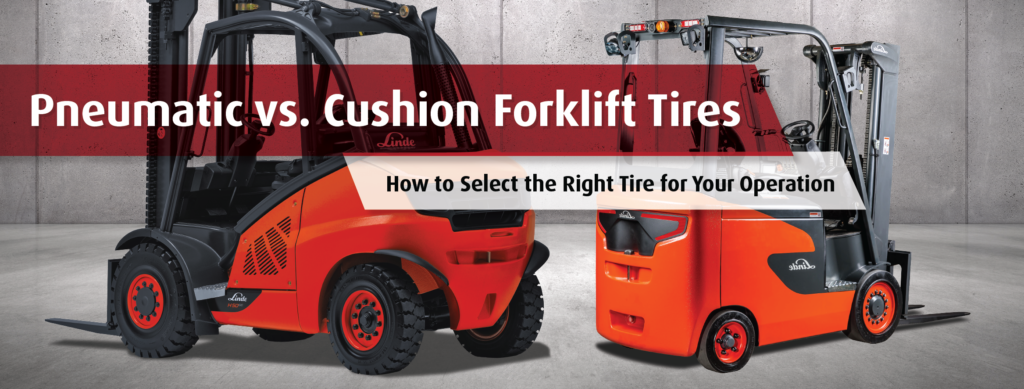|
Matthai Blog Wednesday, November 02 2022
When selecting a forklift for your operation, there are many options to consider before finally deciding on the right equipment for the job. While ensuring the truck you choose matches your environment and can handle the proper capacity limits, choosing the right tires for your forklift is also essential. Different applications require different forklift tires, and it is imperative to select the right kind of tires because it will affect the overall handling and welfare of the forklift. Pneumatic Forklift Tires Pneumatic tires are more commonly used on:
Types of Pneumatic Tires There are two different types of pneumatic tires, solid pneumatics, and air pneumatics. Depending on the environment that your truck will work, knowing the difference between the two tire options will help you make the best decision for your operation.
Pneumatic tires provide a smoother ride for operators as the air-filled tire can provide a bit of bounce when navigating over rough terrain. Cushion Forklift Tires
Cushion forklift tires can’t withstand as much weight as pneumatic tires can but can function in smaller capacities. This ability makes them an attractive option for facilities with less space as their smaller turning radius provides an advantage compared to pneumatic tires. How to Decide Between Pneumatic and Cushion Tires
Consider that the work environment will play a heavy role in making the ultimate decision on tire options. Both cushion and pneumatic tire forklifts can be acquired in any load capacity, ranging from less than 2,000 pounds to more than 200,000 pounds. If you are still having trouble deciding, we are more than happy to offer solutions for your specific situation. At Matthai Material Handling, we understand the importance of choosing the best tire for your forklift to enhance the capabilities of your operation. We know what matters to your operation and how the smallest detail can enhance or detract from your organization. Just give us a call at 410-344-1801 for a consultation and quote. Thursday, October 06 2022
With so many truck options out there, choosing the correct truck for the application can seem like a daunting task. From enhancing productivity to promoting safety, selecting the appropriate truck for your operation can affect multiple layers of your supply chain. What is Forklift Capacity?Forklift capacity is the amount of weight a forklift can safely lift at a specific load center. Lift truck capacity can range anywhere from 3,000 to 70,000 lbs. and offer a multitude of designs to aid in lift efficiency. Each forklift has its own data plate where you can find the rated capacity. Knowing a trucks lift capacity does not necessarily equate to matching product in pounds. For instance, if a forklift’s data plate specifies a lift capacity of 5,000 lbs. that does not necessarily mean the truck can carry any load of 5,000 lbs. The amount of weight a forklift can safely carry will change depending on the way the load is carried and the weight is distributed. What is The Forklift Load Center?The forklift load center is the distance from the front of the truck forks to the center of gravity of the load. Most forklifts use a 24-inch load center, so your load’s center of gravity should not be more than 24 inches from the face of the forks. This measurement is important for operators and operation managers to consider for the safety of their ongoing operations. How Do I Determine What Forklift Capacity I Need?When considering forklift capacity options for your operation ask yourself the following questions:
Factors that Impact Lift CapacityTiresChoosing a forklift, based on lift capacities, involves many more factors than what the data plate states. Each part of the truck offers its own lift capacities and can directly affect the load you intend to carry. For example, the type of tires on the truck will help determine lift abilities. If the truck has small or larger tires, those details will come into play on calculating load size and may require a recalculation of the center of gravity. AttachmentsWarehouse operations will often add forklift attachments to aid the needs of their operation. However, before adding any attachment, operators must consider the effect adding an attachment will have on the truck’s center of gravity. The additional weight is not the only concern, as the horizontal and vertical center of gravities can also affect the overall lifting. To ensure trucks are transporting loads safely, locating the forklift attachment’s data plate will assist in determining proper lift capacity. Center of Gravity ShiftsMost counterbalanced trucks have what is called a stability triangle. The stability triangle is a three-point suspension system that incorporates two front wheels and the center of the steer axle that supports the truck. When the truck is at rest, the center of gravity is within the stability triangle, however, when the truck is in motion (braking, accelerating, and making turns) the center of gravity shifts. Issues that can affect the center of gravity are damaged products, loads un-securely mounted, loads that are off-center, and loads that are exceeding capacity. Get the Right Equipment for Your OperationThere are plenty of other areas to consider when determining the appropriate truck options for your supply chain. Calculating lift capacities and considering additional attachments can be overwhelming for the operator to navigate. That’s why our network of dealers throughout North America are ready to help you find the right truck for the job. Contact us today for your consultation to find the best forklift to meet your operational needs. Sign up for your eNewsletter to be alerted of new content, specials or industry news. |







